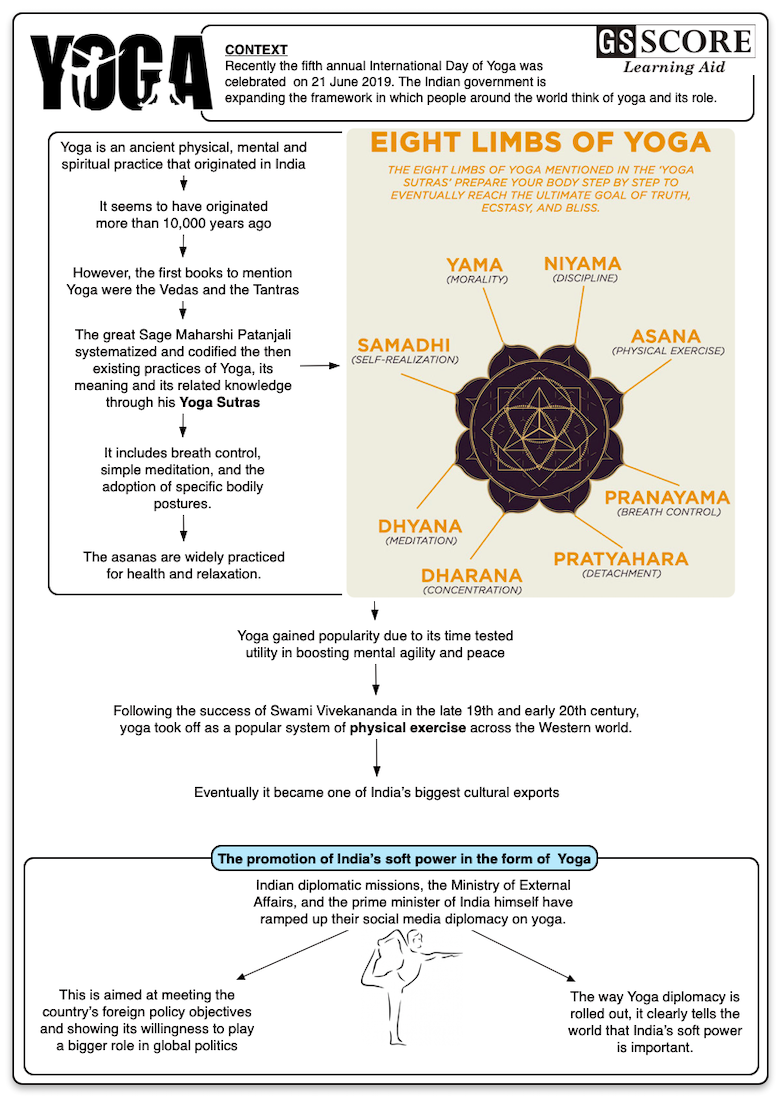

- Recently fifth annual International Day of Yoga was celebrated on Friday, 21 June 2019.
- The Indian government is expanding the framework in which people around the world think of yoga and its role.
Issue
Context
- Recently fifth annual International Day of Yoga was celebrated on Friday, 21 June 2019.
- The Indian government is expanding the framework in which people around the world think of yoga and its role.
About:
- Yoga is gaining popularity due to its time tested utility in boosting mental agility and contributions towards Peace behavior.
- Similar to China’s Panda diplomacy, India is spreading yoga as a proponent of world peace.
- Indian diplomatic missions, the Ministry of External Affairs, and the prime minister of India himself have ramped up their social media diplomacy on yoga.
What is Yoga?
- The word ‘yoga’ derives from Sanskrit and means to join or to unite, symbolizing the union of body and consciousness.
- Yoga cultivates the ways of maintaining a balanced attitude in day-to-day life and endows skill in the performance of one’s actions.
- Yoga is a union of physical, mental as well as spiritual practices and disciplines that is said to have originated in India almost 5,000 years ago.
- The Number of seals and fossil remains of Indus Saraswati valley civilization with Yogic motives and figures performing Yoga Sadhana suggest the presence of Yoga in ancient India.
- While Yoga finds a mention in the Rig-Veda, it became more prominent as hatha yoga texts emerged around the 11th century.
- Yoga includes Asanas, Mudras, Kriyas, Shaktakarmas and Meditation.
History of Yoga
- Though Yoga was being practiced in the pre-Vedic period, the great Sage MaharshiPatanjali systematized and codified the then existing practices of Yoga, its meaning and its related knowledge through his Yoga Sutras.
- Sage Patanjali’s treatise on raja yoga, the Yoga Sutras, says Yoga comprises of yama, niyama, asana, pranayam, pratyahara, dharana, dhyana and samadhi.
- The phallic symbols and seals of idols of mother Goddess of Indus Valley Civilization are suggestive of Tantra Yoga.
- Presence of Yoga is available in folk traditions, Indus valley civilization, Vedic and Upanishadic heritage, Buddhist and Jain traditions, Darshanas, epics of Mahabharat and Ramayana, theistic traditions of Shaivas, Vaishnavas, and Tantric traditions.
- Sun was given highest importance during the Vedic period. The practice of ‘Surya namaskara’ may have been invented later due to this influence.
How well did the Western World know Yoga before IDY event?
Following the success of Swami Vivekananda in the late 19th and early 20th century, yoga took off as a popular system of physical exercise across the Western world.
Analysis
Yogic Practices for Health and Wellness: The Sustainable life
The ten basic components of peace behavior which are regarded as some of the major declared objectives of Yoga are:
- Positive thinking - It involves building a positive self-concept in oneself. Having a positive outlook helps a person to value himself and life in all forms.
- Compassion: - Being Compassionate means having empathetic qualities such as love, kindness, friendliness and doing no harm to others.
- Inner Peace: - Inner Peace as a theme is concerned with resolution of one's own psychological conflicts and problems and discovering peace of mind. It includes ways of understanding the self and the process of thought, controlling emotions such as anger, art of soothing the mind etc.
- Be your true self: - The concept 'Be your true self' means the strength of the character to be honest and direct in expressing one's needs, feelings and thoughts without letting others down. The skills in such behavior are necessary for resolving conflicts and effective social interaction.
- Living together: - People need to learn to work harmoniously in groups with others. The theme living together can accommodate such subtopics as sharing, mutual help, trust building, taking group responsibility, leading and following. Learning cooperation reduces egoistic competitive tendencies in human beings.
- Think critically - Critical thinking on the part of the citizens is a necessary feature of a democratic society. It involves analysis, syntheses, looking at the other sides of an issue, searching for alternatives and logical thinking.
- Non-violent conflict resolution: - It encompasses such skills Necessary for conflict resolution as conflict analyses, negotiation, active listening, mediation, creative problem-solving and alternative solution seeking.
- Respect for human dignity: - Respect for human dignity is based on the concepts of human rights, duties and justice. It attempts to develop a consciousness that recognizes and respects one's own and others' rights.
- Peace in community: - Building peace in community means providing opportunities for its members to be open to social realities and understand people's problems and work with them.
- Care for the planet: - The health of the planet has direct and immediate influence on the destiny of mankind. Values like peace with nature, preservation of nature, appreciation and admiration of natural environment, reuse, repair, recycling natural resources, etc. are included in this theme
Clearing Misconceptions about Yoga:
- For many, the practice of yoga is restricted to Hatha Yoga and Asanas (postures).
- However, among the Yoga Sutras, just three sutrasare dedicated to asanas. Fundamentally, hatha yoga is a preparatory process so that the body can sustain higher levels of energy.
- The process begins with the body, then the breath, the mind, and the inner self.
- Yoga is also commonly understood as a therapy or exercise system for health and fitness. While physical and mental health are natural consequences of yoga, the goal of yoga is more far-reaching.
- Yoga is about harmonizing oneself with the universe. It is the technology of aligning individual geometry with the cosmic, to achieve the highest level of perception and harmony.
- Yoga does not adhere to any particular religion, belief system or community; it has always been approached as a technology for inner wellbeing.
- Anyone who practices yoga with involvement can reap its benefits, irrespective of one’s faith, ethnicity or culture.
Why is yoga needed in present conflicting times?
- Yoga asana's and spirituality transcends religious, regional and virtually all forms of barriers.
- It helps to seek humanity in diversity - responsible consumerism (SDG 12) with social well-being.
- The concept of "VasudhaivKutumbkam" is inherently linked with sustainable life style which is a major component of Yoga.
Promotion of India’s soft power in the form of Yoga
- This is aimed at meeting the country’s foreign policy objectives and showing its willingness to play a bigger role in global politics.
- While previous Indian governments understood and recognized the value of soft power to further India’s foreign policy goals, attempts have been largely ad hoc.
- However, the way Yoga diplomacy is rolled out (even bypassing Buddhist diplomacy in its social media coverage), it clearly tells the word that India’s soft power is important.
- Yoga has become nothing less than a geopolitical tool.
Learning Aid
Practice Question:
It has been pointed out by several practitioners that yoga is effective in generating internal peace. Can this peace be channelized to invoke world peace at a time when it is more fragmented? Discuss.


